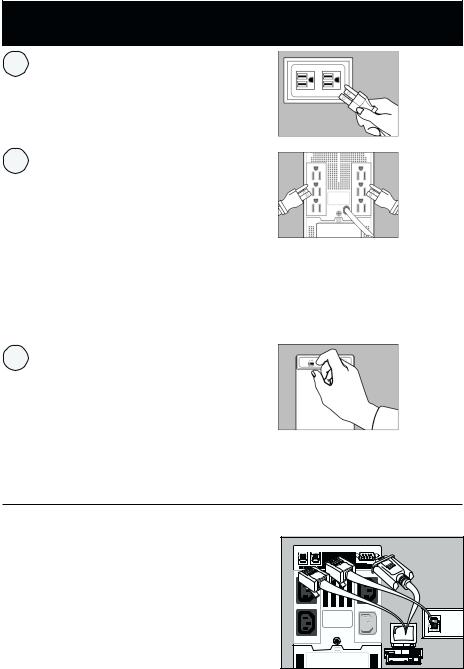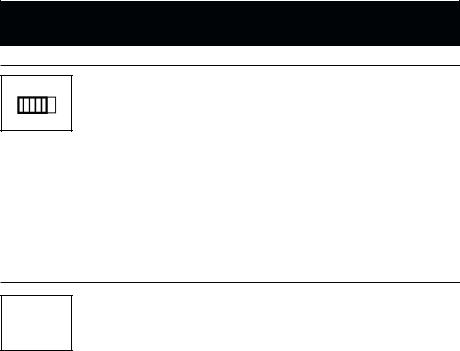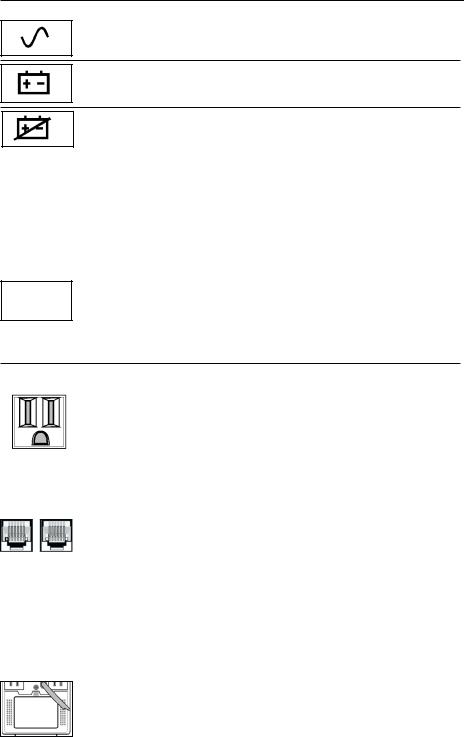Tripp Lite OmniPro 675, OmniSmart 450 PNP, OmniSmart 675 PNP, OmniSmart 300 PNP User Manual

1111 W. 35th Street
Chicago, IL 60609 USA
Customer Support: (773) 869-1234
www.tripplite.com
Owner's Manual
OMNISMART™ OMNIPRO™
Line-Interactive UPS Systems (120V)
ESPAÑOL: p. 7
FRANÇAIS: p. 14
Safety: |
p. 2 |
|
|
Quick Installation: |
p. 3 |
|
|
|
|
|
|
|
Basic Operation: |
p. 4 - 5 |
|
|
|
|
|
|
|
Storage & Service: |
p. 6 |
|
|
|
|
|
|
|
Specifications: |
p. 6 |
|
|
|
|
Copyright ©1999 Tripp Lite. All rights reserved. OmniSmart™ and OmniPro™ are trademarks of Tripp Lite.
1

Safety
This manual contains important instructions and warnings that should be followed during the installation, operation and storage of all Tripp Lite UPS Systems.
UPS Location Warnings
•Install your UPS indoors, away from excess moisture or heat, dust or direct sunlight.
•For best performance, keep the indoor temperature between between 32º F and 104º F (0º C and 40º C).
•Leave adequate space around all sides of the UPS for proper ventilation.
UPS Connection Warnings
•Connect your UPS to a properly grounded AC power outlet. Do not modify the UPS's plug. Do not use adapters that eliminate the UPS's ground line.
•Do not plug your UPS into itself; this will damage the UPS and void your warranty.
•If you are connecting your UPS to a motor-powered AC generator, the generator must provide clean, filtered computer-grade output.
Equipment Connection Warnings
•Do not use Tripp Lite UPS Systems for life support appliances in which a malfunction of failure of a Tripp Lite UPS System could cause failure or significantly alter the performance of a life-support device.
•Do not connect surge suppressors to the output of your UPS. This may damage your UPS and will void both the surge suppressor and UPS warranties.
Battery Warnings
•Your UPS does not require routine maintenance. Do not open your UPS for any reason. There are no user-serviceable parts inside.
•Battery replacement must be performed by qualified service personnel. Because the batteries present a risk of electrical shock and burn from high short-circuit current, observe proper precautions. Unplug and turn off the UPS before performing battery replacement. Use tools with insulated handles, and replace the existing batteries with the same number and type of new batteries (Sealed Lead-Acid). Do not open the batteries. Do not short or bridge the battery terminals with any object.
•The UPS batteries are recyclable. Refer to local codes for disposal requirements, or in the USA only call 1-800-SAV-LEAD for recycling information. Do not dispose of the batteries in a fire.
•Do not attempt to add external batteries.
2

Quick Installation
1 Plug your UPS into an electrical outlet.
2 Plug your computer, monitor and external modem into battery-supported outlets. Plug other equipment into surge-only outlet(s) .*
*Separate battery-supported/surge and surge-only outlet(s) are available only on select models (identified on the back of your UPS). Your UPS is designed to support only computer equipment. You will overload your UPS if you connect household appliances, laser printers or surge suppressors to battery-supported outlets.
Set your UPS’s “OFF – ON” 3 Switch.**
USA, Canada & Western Europe
· Set it and leave it “ON” at all times.
All Other Countries
·Set to “OFF” when you are not using connected equipment.
(WARNING! When set to “OFF,” UPS will not provide battery backup during a blackout or brownout)
·Set to “ON” when you are using connected equipment.
**See Basic Operation section for the Switch Function, UPS Conditions and Setting Advantages.
–Optional Installation–
(Select models)†
OPTION1(Phone-LineSurgeSuppression)
Using telephone cords, connect your wall jack to the UPS jack marked “LINE” (or “IN”). Connect your equipment to the UPS jack marked “EQUIP” (or “OUT”).
OPTION 2 (UPS Software)
Using Tripp Lite cable (if supplied), connect the DB9 port of your computer to the DB9 port of your UPS. Load software (if supplied) and run installation program appropriate for your operating system.
†Phone line and DB9 port connections are optional. Your UPS will function properly without these connections. Make sure the equipment you connect to the UPS’s telephone jacks is also protected against surges on the AC line. Select models protect TWO lines on one cable simultaneously (see specifications.) If you have one of these models and want to protect two lines that do NOT travel through one cable, you must use "Y" splitters appropriate to your application to adapt them to your UPS's phone jacks.
3

Basic Operation
Switches
With your UPS plugged in, set this switch according to the OFF ON recommendations in Step 3 of the Quick Installation section.
"ON" Position
Function: ENABLES battery backup. UPS Conditions: The UPS battery is charging. Power is ON at the UPS receptacles. The " " indicator light is illuminated. Setting Advantages: Provides battery backup during blackouts or brownouts.
" indicator light is illuminated. Setting Advantages: Provides battery backup during blackouts or brownouts.
"OFF" Position
Function: DISABLES battery backup. UPS Conditions: The UPS battery is charging. Power is ON at the UPS receptacles. The " " indicator light is illuminated. The "
" indicator light is illuminated. The " " indicator light is flashing. Setting Advantages: Continues to charge the battery when power is present while turning OFF the inverter to prevent battery backup operation when equipment is not in use.
" indicator light is flashing. Setting Advantages: Continues to charge the battery when power is present while turning OFF the inverter to prevent battery backup operation when equipment is not in use.
Available on select models
Use this momentary switch to do three things:
Silence the UPS alarm*
Move this switch to the left and release it. Note: When the battery is nearly depleted the alarm resumes (and cannot be silenced) to alert you to immediately shut down connected equipment.
*The UPS alarm consists of a series of short beeps followed by a brief pause. The alarm is activated when the UPS switches to battery during a blackout or brownout.
Test your UPS's battery charge**
Leave your connected equipment ON. With your UPS plugged in and turned ON, move this switch to the left; hold it there for 2 seconds and release it. The UPS will momentarily switch to battery to test its charge. If the UPS alarm sounds or the properlysized load is not supported, let your UPS charge its batteries for 12 hours and repeat the test. If alarm still sounds, contact Tripp Lite for service. CAUTION: Do not unplug your UPS to test its batteries. This will remove safe electrical grounding and may introduce a damaging surge into your network connections.
**If your model is not equipped with this switch, you can still test your UPS batteries. First plug your UPS into a grounded surge suppressor (which will maintain the ground connection), then turn the surge suppressor's power switch OFF.
Cold-Start your UPS
If your UPS is equipped with a MUTE/TEST switch, you may “cold start” it and use it as a stand-alone power source when utility power is not present, providing that the UPS's battery is charged. To “cold start” your UPS, first turn the "OFF/ON" switch ON. Then, move the MUTE/TEST switch to the left, hold momentarily and release when the "  " indicator light begins to flash.
" indicator light begins to flash.
4

Indicator Lights
All Indicator Light descriptions apply when the UPS is plugged into a wall outlet and turned on.
This green light will turn ON whenever your UPS is plugged in and receiving normal AC line power.
This red light will turn ON when your UPS is providing your equipment with battery power.
This yellow light will turn ON continuously after you test your UPS battery’s charge with the “Mute/Test” Switch to indicate that the UPS’s battery is less than fully charged. If it stays on continuously, contact
Available on |
Tripp Lite for service. The light will flash after you set the “OFF/ON” |
||
select models |
|||
Switch to the “OFF” position to indicate that the UPS will not provide |
|||
|
|||
|
battery backup during a blackout or brownout. |
||
|
|
|
|
|
Whenever your UPS is automatically correcting high or low AC line |
||
|
|||
|
voltage, this green light will turn ON and the UPS will gently click. The |
||
|
more the UPS has to correct voltage, the more the green light will turn |
||
Available on |
ON and the more the UPS will click. These are both normal, automatic |
||
select models |
operations of your UPS, and no action is required on your part. |
||
|
|||
|
|
|
|
Available on select models
This red light will turn ON when the UPS’s capacity has been exceeded while it is operating from battery power (either during a self-test or during a blackout). Remove overload from battery-supported outlets immediately.
Other UPS Features
AC Receptacles
The receptacles provide your connected equipment with AC line power during normal operation and battery power during blackouts and brownouts. They also protect your equipment against damaging surges and line noise. Select models, however, feature “surge-only” receptacle(s) (identified on the back of the UPS) that provide peripherals with surge protection without committing precious battery power to support them during blackouts.
RJ11 Telephone Jacks (Available on select models)
These jacks protect your equipment against telephone line surges. Connecting your equipment to these jacks is optional. Your UPS will still work properly without this connection.
DB9 Port (Available on select models)
The DB9 port connects your UPS to any workstation or server. Use with Tripp Lite software and cabling to automatically save open files and shut down equipment during a blackout. This port sends contact-closure signals to indicate line-fail and lowbattery status. Contact Tripp Lite Customer Support for more information.
Battery Replacement Door
Under normal conditions, the original battery in your UPS will last several years. Battery replacement should be performed only by qualified service personnel. Refer to “Battery Warnings” in the Safety section on page 2.
5

Storage & Service
Storage
First turn your UPS OFF and disconnect its power cord from the wall outlet. Then disconnect all equipment to avoid battery drain. If you plan on storing your UPS for an extended period of time, fully recharge the UPS batteries once every three months by plugging the UPS into a live AC outlet and letting the UPS charge for 4 to 6 hours. If you leave your UPS batteries discharged for an extended period of time, they will suffer a permanent loss of capacity.
Service
If returning your UPS for service, contact your local Tripp Lite dealer or distributor. They will refer you to a service center. Please carefully pack the UPS using the ORIGINAL PACKING MATERIAL that came with the unit. Enclose a letter describing the symptoms of the problem. If the UPS is within the warranty period, enclose a copy of your sales receipt.
Specifications
OmniSmart 300 PNP |
OmniSmart 450 PNP |
OmniSmart 675 PNP |
|
Output Capacity (VA/Watts): |
300/180 |
450/300 |
675/425 |
Battery Runtime (Half Load/ |
|
|
|
Full Load) Minutes: |
17/5 |
17/5 |
17/5 |
Battery Recharge Time: |
2-4 hrs. |
2-4 hrs. |
2-4 hrs. |
Approvals: |
UL, cUL, NOM |
UL, cUL, NOM |
UL, cUL, NOM |
Modem/Fax Protection |
|
|
|
(starts at 260V): |
1 line |
1 line |
2 line |
OmniSmart 850 PNP |
OmniSmart 1050 PNP |
OmniSmart 1400 PNP |
|
Output Capacity (VA/Watts): |
850/570 |
1050/680 |
1400/940 |
Battery Runtime (Half Load/ |
|
|
|
Full Load) Minutes: |
26/9 |
23/7 |
24/8 |
Battery Recharge Time: |
2-4 hrs. |
2-4 hrs. |
2-4 hrs. |
Approvals: |
UL, cUL, NOM |
UL, cUL, NOM |
UL, cUL, NOM |
Modem/Fax Protection |
|
|
|
(starts at 260V): |
— |
— |
— |
|
OmniPro 280 |
OmniPro 450 |
OmniPro 675 |
Output Capacity (VA/Watts): |
280/175 |
450/300 |
675/425 |
Battery Runtime (Half Load/ |
|
|
|
Full Load) Minutes: |
17/5 |
17/5 |
17/5 |
Battery Recharge Time: |
2-4 hrs. |
2-4 hrs. |
2-4 hrs. |
Approvals: |
UL, cUL, NOM |
UL, cUL, NOM |
UL, cUL, NOM |
Modem/Fax Protection |
|
|
|
(starts at 260V): |
— |
1 line |
2 line |
ALLMODELS:
InputVoltage/Frequency(120V/60Hz); On-LineInputVoltageRange(75-147volts);Voltage-RegulatedOutputVoltageRange(120V +6% / -12%); On Battery Output Voltage Range (120V +/- 5%); Output Waveform Line Mode (filtered sinewave); Output Waveform Battery Mode (PWM sine wave); AC Surge Suppression (exceeds IEEE 587 Cat. A & B standards); AC Noise Attenuation (>40 dB); AC Protection Modes (H to N, H to G, N to G).
FCC Part 68 Notice (U.S. only)
If your Modem/Fax Protection causes harm to the telephone network, the Telephone Company may temporarily discontinue your service. If possible, they will notify you in advance. If advance notice isn’t practical, you will be notified as soon as possible. You will be advised of your right to file a complaint with the FCC. Your telephone company may make changes in its facilities, equipment, operations or procedures that could affect the proper operation of your equipment. If it does, you will be given advance notice to give you an opportunity to maintain uninterrupted service. If you experience trouble with this Modem/Fax Protectionequipment, please contact the Manager of Technical Support, Tripp Lite; 1111 W. 35th Street, Chicago, Illinois 60609; Phone: (773) 869-1234, for repair/warranty information. The telephone company may ask you to disconnect this equipment from the network until the problem has been corrected or you are sure the equipment is not malfunctioning. There are no repairs that can be made by the customer to the Modem/Fax Protection. This equipment may not be used on coin service provided by the telephone company. Connection to party lines is subject to state tariffs. (Contact your state public utility commission or corporation commission for information.)
6
